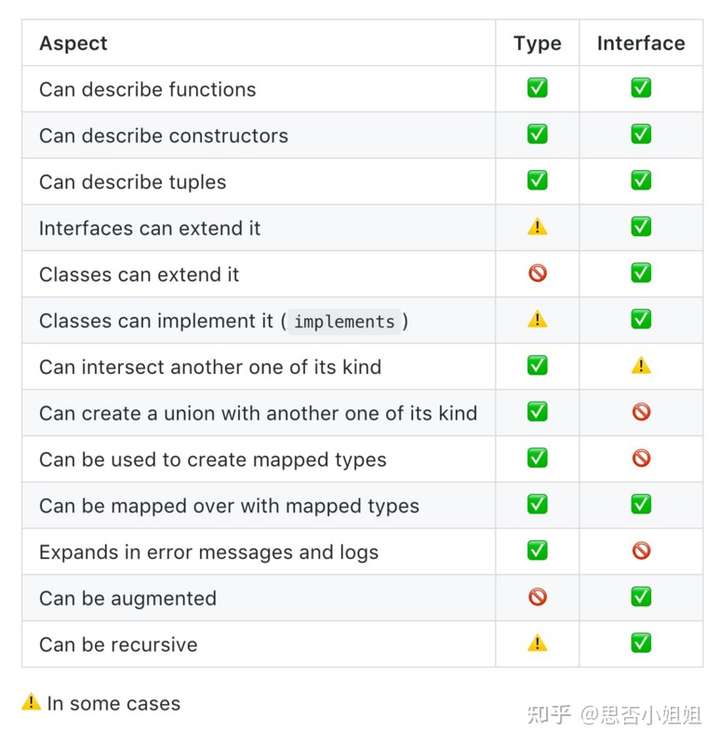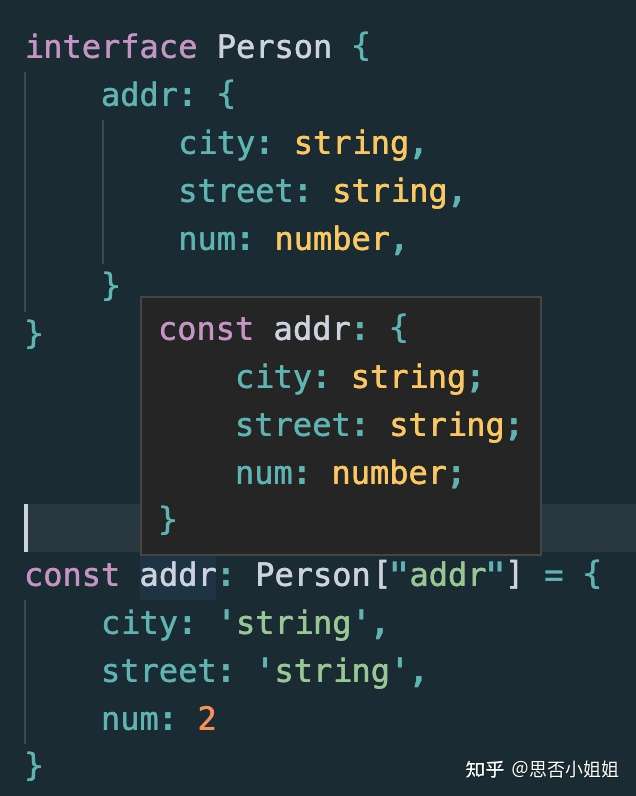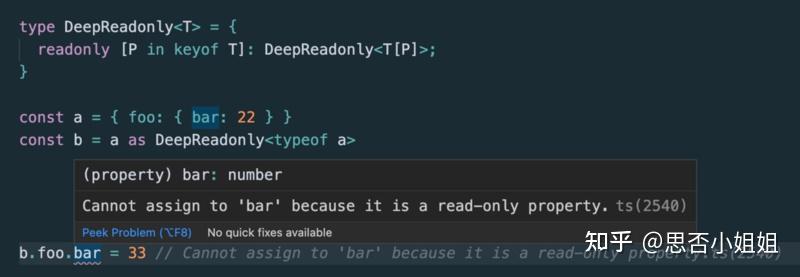TypeScript 中提升幸福感的 10 个高级技巧
以下是我在工作中总结到的经常会用到的 TypeScript 技巧。
1. 注释
通过 /** */ 形式的注释可以给 TS 类型做标记提示,编辑器会有更好的提示:
/** This is a cool guy. */
interface Person {
/** This is name. */
name: string,
}
const p: Person = {
name: 'cool'
}如果想给某个属性添加注释说明或者友好提示,这种是很好的方式了。


2. 接口继承
和类一样,接口也可以相互继承。
这让我们能够从一个接口里复制成员到另一个接口里,可以更灵活地将接口分割到可重用的模块里。
interface Shape {
color: string;
}
interface Square extends Shape {
sideLength: number;
}
let square = <Square>{};
square.color = "blue";
square.sideLength = 10;一个接口可以继承多个接口,创建出多个接口的合成接口。
interface Shape {
color: string;
}
interface PenStroke {
penWidth: number;
}
interface Square extends Shape, PenStroke {
sideLength: number;
}
let square = <Square>{};
square.color = "blue";
square.sideLength = 10;
square.penWidth = 5.0;
3. interface & type
TypeScript 中定义类型的两种方式:接口(interface)和 类型别名(type alias)。
比如下面的 Interface 和 Type alias 的例子中,除了语法,意思是一样的:
Interface
interface Point {
x: number;
y: number;
}
interface SetPoint {
(x: number, y: number): void;
}Type alias
type Point = {
x: number;
y: number;
};
type SetPoint = (x: number, y: number) => void;而且两者都可以扩展,但是语法有所不同。此外,请注意,接口和类型别名不是互斥的。接口可以扩展类型别名,反之亦然。
Interface extends interface
interface PartialPointX { x: number; }
interface Point extends PartialPointX { y: number; }Type alias extends type alias
type PartialPointX = { x: number; };
type Point = PartialPointX & { y: number; };Interface extends type alias
type PartialPointX = { x: number; };
interface Point extends PartialPointX { y: number; }Type alias extends interface
interface PartialPointX { x: number; }
type Point = PartialPointX & { y: number; };它们的差别可以看下面这图或者看 TypeScript: Interfaces vs Types。

所以檙想巧用 interface & type 还是不简单的。
如果不知道用什么,记住:能用 interface 实现,就用 interface , 如果不能就用 type 。
4. typeof
typeof 操作符可以用来获取一个变量或对象的类型。
我们一般先定义类型,再使用:
interface Opt {
timeout: number
}
const defaultOption: Opt = {
timeout: 500
}有时候可以反过来:
const defaultOption = {
timeout: 500
}
type Opt = typeof defaultOption
当一个 interface 总有一个字面量初始值时,可以考虑这种写法以减少重复代码,至少减少了两行代码是吧,哈哈~
5. keyof
TypeScript 允许我们遍历某种类型的属性,并通过 keyof 操作符提取其属性的名称。
keyof 操作符是在 TypeScript 2.1 版本引入的,该操作符可以用于获取某种类型的所有键,其返回类型是联合类型。
keyof 与 Object.keys 略有相似,只不过 keyof 取 interface 的键。
const persion = {
age: 3,
text: 'hello world'
}
// type keys = "age" | "text"
type keys = keyof Point;写一个方法获取对象里面的属性值时,一般人可能会这么写
function get1(o: object, name: string) {
return o[name];
}
const age1 = get1(persion, 'age');
const text1 = get1(persion, 'text');但是会提示报错

因为 object 里面没有事先声明的 key。
当然如果把 o: object 修改为 o: any 就不会报错了,但是获取到的值就没有类型了,也变成 any 了。

这时可以使用 keyof 来加强 get 函数的类型功能,有兴趣的同学可以看看 _.get 的 type 标记以及实现
function get<T extends object, K extends keyof T>(o: T, name: K): T[K] {
return o[name]
}
6. 查找类型
interface Person {
addr: {
city: string,
street: string,
num: number,
}
}当需要使用 addr 的类型时,除了把类型提出来
interface Address {
city: string,
street: string,
num: number,
}
interface Person {
addr: Address,
}还可以
Person["addr"] // This is Address.比如:
const addr: Person["addr"] = {
city: 'string',
street: 'string',
num: 2
}
有些场合后者会让代码更整洁、易读。
7. 查找类型 + 泛型 + keyof
泛型(Generics)是指在定义函数、接口或类的时候,不预先指定具体的类型,而在使用的时候再指定类型的一种特性。
interface API {
'/user': { name: string },
'/menu': { foods: string[] }
}
const get = <URL extends keyof API>(url: URL): Promise<API[URL]> => {
return fetch(url).then(res => res.json());
}
get('');
get('/menu').then(user => user.foods);

8. 类型断言
Vue 组件里面经常会用到 ref 来获取子组件的属性或者方法,但是往往都推断不出来有啥属性与方法,还会报错。
子组件:
<script lang="ts">
import { Options, Vue } from "vue-class-component";
@Options({
props: {
msg: String,
},
})
export default class HelloWorld extends Vue {
msg!: string;
}
</script>父组件:
<template>
<div class="home">
<HelloWorld
ref="helloRef"
msg="Welcome to Your Vue.js + TypeScript App"
/>
</div>
</template>
<script lang="ts">
import { Options, Vue } from "vue-class-component";
import HelloWorld from "@/components/HelloWorld.vue"; // @ is an alias to /src
@Options({
components: {
HelloWorld,
},
})
export default class Home extends Vue {
print() {
const helloRef = this.$refs.helloRef;
console.log("helloRef.msg: ", helloRef.msg);
}
mounted() {
this.print();
}
}
</script>因为 this.$refs.helloRef 是未知的类型,会报错误提示:

做个类型断言即可:
print() {
// const helloRef = this.$refs.helloRef;
const helloRef = this.$refs.helloRef as any;
console.log("helloRef.msg: ", helloRef.msg); // helloRef.msg: Welcome to Your Vue.js + TypeScript App
}但是类型断言为 any 时是不好的,如果知道具体的类型,写具体的类型才好,不然引入 TypeScript 冒似没什么意义了。
9. 显式泛型
$('button') 是个 DOM 元素选择器,可是返回值的类型是运行时才能确定的,除了返回 any ,还可以
function $<T extends HTMLElement>(id: string): T {
return (document.getElementById(id)) as T;
}
// 不确定 input 的类型
// const input = $('input');
// Tell me what element it is.
const input = $<HTMLInputElement>('input');
console.log('input.value: ', input.value);

函数泛型不一定非得自动推导出类型,有时候显式指定类型就好。
10. DeepReadonly
被 readonly 标记的属性只能在声明时或类的构造函数中赋值。
之后将不可改(即只读属性),否则会抛出 TS2540 错误。
与 ES6 中的 const 很相似,但 readonly 只能用在类(TS 里也可以是接口)中的属性上,相当于一个只有 getter 没有 setter 的属性的语法糖。
下面实现一个深度声明 readonly 的类型:
type DeepReadonly<T> = {
readonly [P in keyof T]: DeepReadonly<T[P]>;
}
const a = { foo: { bar: 22 } }
const b = a as DeepReadonly<typeof a>
b.foo.bar = 33 // Cannot assign to 'bar' because it is a read-only property.ts(2540)




